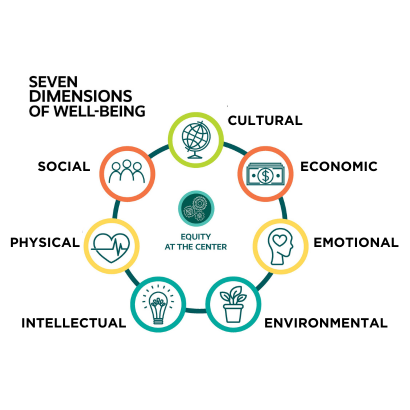
Throughout the summer, NRPA’s social media highlighted the seven dimensions of well-being. You may also remember them from the 2023 NRPA Annual Conference activity, where the ways in which park and recreation professionals were supporting the dimensions were shared on flowers and leaves. We’ve been sharing the seven dimensions for a couple of years now as we’ve leaned into the critical role park and recreation professionals play in building inclusive, resilient and thriving communities, and we’re excited to keep sharing them moving forward, as they become an integral part of NRPA’s 2025-2030 Strategic Plan.
NRPA’s seven dimensions of well-being are adapted from several evidence-based frameworks and aligned with the strengths, assets and opportunities that exist within parks and recreation to advance equity, resilience and health and well-being. The seven interdependent and interconnecteddimensions of well-being include: cultural, economic, environmental, intellectual, mental, physical and social. At the center of these seven dimensions is equity, reflecting a deep commitment to addressing and rectifying legacies of inequity and injustice in our communities — especially those created and/or perpetuated through park and recreation systems — to ensure the benefits of parks and recreation are shared by everyone.
To better support park and recreation professionals as they advance the seven dimensions, we’ve created a set of new resources to help contextualize each dimension with sample strategies and examples from the field. Each sheet breaks down the dimensions into:
-
The Vision: What is the outcome when the dimension is advanced and achieved?
- Example: Emotional Well-Being — Communities understand, embrace and promote emotional, behavioral and spiritual wellness, and they provide spaces, programs and services that support emotional health. Community members can develop and explore feelings, values and attitudes; practice mindfulness and self-awareness; find a sense of purpose and meaning; and manage emotions and behaviors.
-
How Parks and Recreation Promote Well-Being: What is the role of parks and recreation in supporting this dimension?
- Example:Emotional Well-Being — Park and recreation agencies support and promote emotional well-being through programs, resources and the spaces they manage. Park and recreation professionals support community members who are experiencing or are impacted by rising rates of mental health conditions, substance use disorder, homelessness or other adversities. Agencies are establishing new practices, programs and services to better support and protect emotional health and connect people to needed mental and behavioral health services.
-
Examples of Advancing Well-Being: What does implementation of this dimension look like?
- Example:Emotional Well-Being
- Provide trauma-informed and mental health first aid training to employees, community members and partners.
- Partner with mental health providers to offer screenings or design educational programming centered around managing stress and promoting well-being.
- Create spaces and opportunities that build a sense of purpose like volunteerism, spending time outdoors and in nature, and community service.
- Example:Emotional Well-Being
- In Practice: Case studies from the field
- Example:Emotional Well-Being — The Stark County Park District in Canton, Ohio, partnered with Stark Mental Health Addiction and Recovery, a local mental health agency, to create a “Mindfulness Walk.” The goal was to provide an added benefit to a community that has dealt with an increased number of deaths by suicide. The walk, which features 10 stations, was designed in partnership with mental health professionals; several scout groups and park district staff helped build it. The stations — which include a Zen sand garden, a musical instrument, stacking stones and a labyrinth — promote relaxation, focus, awareness, reflection and embracing the present moment.
The intention behind this new suite of resources is to ensure that park and recreation professionals can explore guidance, examples from the field, and tangible strategies that can be implemented across park and recreation systems to maximize community benefits across the seven dimensions.
As an integral part of NRPA’s new strategic plan, we’re eager to hear how you are advancing the seven dimensions, centering equity, and ensuring that community members can achieve an optimal state of health and well-being through your programs and services.
Access the Seven Dimensions of Well-Being Resources
Maureen Neumann (she/her) is a senior program manager at NRPA.


